US Army H-45 Heater Stove
On Ebay:https://www.ebay.com/h45
Plastic Jerry Cans (that fit the can adapter)
Also on Ebay
Yet another brutal winter has a lot of people thinking about heating their homes when the power goes out. Even a few days without heat can be deadly, let alone the potential damages to your home from frozen water pipes and expanding ice. Imagine a whole winter without heat! Could you survive it? How would you survive it is the better question. Because if you live in the country, it is easy to just own an emergency wood stove, and keep a cord of wood covered in the back yard. That will keep you warm enough, and keep your pipes from freezing. But what if you live in an urban setting, or even a suburban area where you don’t have a lot of land to store wood?
If you heat with home heating oil, the crazy thing about losing heat when the power goes out is that you have a couple hundred gallons of BTU rich fuel sitting right their in your basement tank. The reason you lose heat is that the igniter and pumps use electricity. Home oil burners don’t work just gravity fed. That fuel sits there, completely useless.
The same will be true for long term survival. You may not have a lot of trees to burn in your neighborhood using a traditional woodstove, but my guess is that between your oil tank, and the tanks of your bugged out or dead neighbors, you could probably survive several winters without having to carry fuel more than a mile. Add to that all the gasoline that is in all of the cars that get left behind and if there is a good chance that the collapse will burn itself out before you burn through all of your fuel. Life at some point will return to a semblance of normal…I hope. So what you really need is a heater that can heat enough of your home to live in, without the use of electricity.
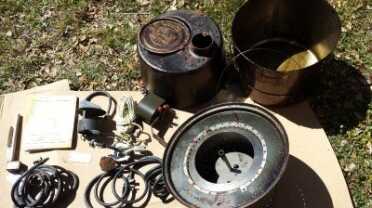
These are the parts that came with my stove. Top right are the top and bottom cans, then below is the burner assembly and to the left the fuel regulator, fuel lines, can adapter and not shown are the vent pipes. As you can see, they are somewhat corroded and rusted because the box had gotten wet and stayed wet for months.
Thankfully, the good old US Army has had to deal with this very same issue, and they solved it. The H-45 stove burns diesel, which is the same as home heating fuel, as well as gasoline and jet fuel. No electricity is required, and it will provide between 15,000 and 45,000 BTUs. If you are a genuine prepper who actually pulls the trigger on the things I show you in this series, the best news of all is that the army recently surplused hundreds of them, and they are on Ebay from less than $100 to about $200, depending on the seller and how saturated the listings are at any given time. Search for (h45,h-45)(heater,stove) and it will generally bring up all available. As of this writing there is a seller at $109 with free shipping. If you click in, buy it immediately, because they will not be there in a few hours after this article gets mailed to 800,000 people.
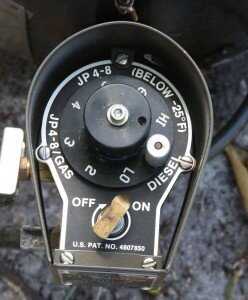
This is the fuel regulator. You set the silver knob to the fuel type, and the dial then corresponds to the heat level.
My test of this stove brought to light a few important problems you might face should you acquire one and let it sit before testing it for yourself. Mine came in a sealed box covered with silver wrapping, reported to be unissued, and I bought it almost two years ago from a prior batch of Ebay sellers who had picked them up at the large surplus auctions. On opening my box, it was wet inside. The storage shed that I had kept it in had a leaked that was fixed several months ago, and I hadn’t realized that the heater box had gotten wet. All of my brass connectors were green, and there was a grey corrosion on all the galvanized parts. The stove itself had been coated in what looks like used motor oil, so it was mostly unrusted, but the apparently blued stovepipe had a decent amount of rust. And alas, surprise surprise, my stove, “new and unissued,” was missing a critical piece, the breather tube that goes inside the gas can.
Therefore, I have a lot of pictures here so you can see the parts that came with my stove, as well as the missing part, and you’ll be able to see them all set up and working. My fix for the missing part was simple, and it worked.
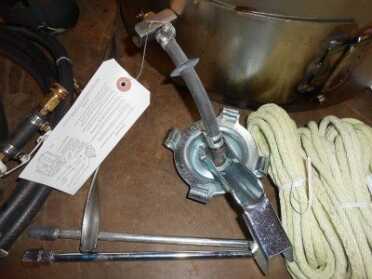
Here you can see the gas cap adapter and the two tubes (bottom left) that my stove was missing from the kit that are used with the adapter to allow the can to breath while the fuel drips out.
The only downside to this heater is that it throws a ton of heat even at its lowest setting. By “tent heater” I guess the Army means gigantic tent, because I think it would spontaneously combust anything short of gigantic. After burning one can of diesel in it I determined that the H-45 burns a little less than a half of a gallon of diesel per hour at the lowest setting with the heater dial set on diesel. If I didn’t live in South Florida and I actually cared about using my H45 for anything but this article, I would try the settings for the thinner fuels to see if perhaps you can get more time and less BTUs per hour out of the same can of fuel, or it may be for another article we’ll see.
The only thing you absolutely must buy unless you are a DIY’er is an “old style” military Jerry can. These cans had wide screw holes, and the adapter for the heater only fits these holes. The new style cans cannot be used, but you can find the old style steel cans generally on Ebay for about $50 with shipping. Don’t worry if the outside is a little ugly. The inside of these cans is enameled so they don’t rust out.
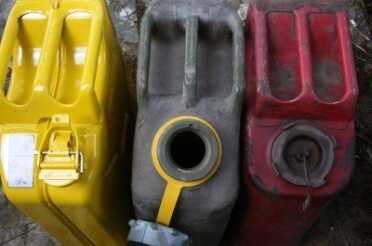
The other thing you need, unless you intend to make your own fuel line system, is an “old style” Jerry can. On the right, the red one is what you are looking for. They are usually $50 and ugly, but the insides are enameled and they last forever. The middle one is the plastic can I have linked to in the article, and on the left is the yellow version of the modern Jerry can you’ll find all over the place online for about $35 each. YOU CAN’T USE THE MODERN CANS like the yellow one.
I found a seller on Ebay selling a plastic can that has a cap with outside threads, but the cans also have inside threads that fit the H-45 adapter. He sells them in twos for $100 plus shipping and can be found at this link. Again, if you are smart and you intend to use this heater, jump on the cans before he runs out. The only thing with the plastic cans is to be careful not to strip the threads.
The other thing you kind of need but could get by without is the stand for the can. This could be made very easily yourself with wood, or you could figure out some other way to suspend the can. The triple leg stand will come up in your H45 search on Ebay, and they go for $25 or so plus shipping. If you want to use the heater for ice fishing or other portable application it is well worth the investment because it folds up.
The first time you fire up your stove, don’t take it lightly. I initially was sloppy with tightening the cap down and it got much hotter than it should have because of the extra oxygen getting in through the gaps.
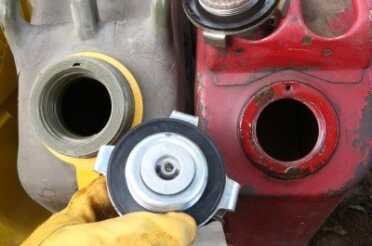
The cap adapter fits the inside of the plastic can spout and the standard hole on the red can. The rubber gasket comes with the can adapter.
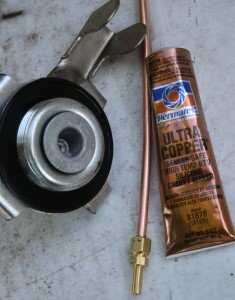
I had to make my own breather tube that reaches from cap adapter to above the fuel line when the can is inverted.
And I should mention also that the H-45 does double as a woodstove. The fuel burning gassifier system comes right out and you can use the stove as a big can with a chimney, to burn just about anything. I have seen sellers on Ebay offering a specially made grate for the H-45, but they don’t seem to be on there selling right now.
Take a look through the pictures here and make sure that you are getting as many of the required parts as you can. The fuel lines can easily be created from Home Depot parts. Just use the correct fuel hose. The fitting that come with the stove are mostly wrenchless, but you do need a wrench to connect the double female hose to the bottom of the burner assembly. I also used teflon tape for that connection. The burner/gassifier comes assembled in all the kits I have seen, and most come with directions. Other than that you have the top and bottom cans, the control dial assembly, the special gas cap adapter, and two rods that screw together to form the breather for the can. Those rods were what my can was missing, so I made a replacement using a brass hose barb, some copper tubing and a tube of high temp silicone gasket material I had for another project in this series. Most kits will come with blued steel pop together vent pipe, and a vent cap. Fortunately the stove uses standard 4″ vent pipe, so you can buy that at Home Depot, along with an elbow to lead your pipe out of a basement window.
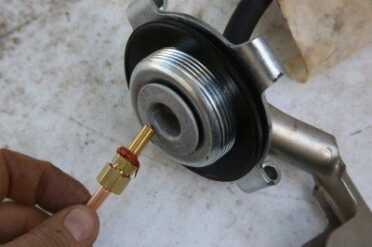
Inside the cap there is a threaded hole for that silver tube. I used gasket material and this hose barb and glued my system in.
More than anything this project showed me the importance of actually testing the survival stuff that I buy “just in case.” I would have been sunk without a breather tube for the can, and I would have been sunk had I never figured out that you can’t use a modern Jerry can as well. It was only after I opened everything up and put it together that I realized that I had bought the wrong kind of Jerry can, and that I was missing a crucial piece. Grab one of the kits from this guy while you still can. At $500 this stove is a steal when you think about the survival implications of all that free fuel sitting in all the empty houses that will be in your neighborhood. For $100 or $200? Pa…lease!

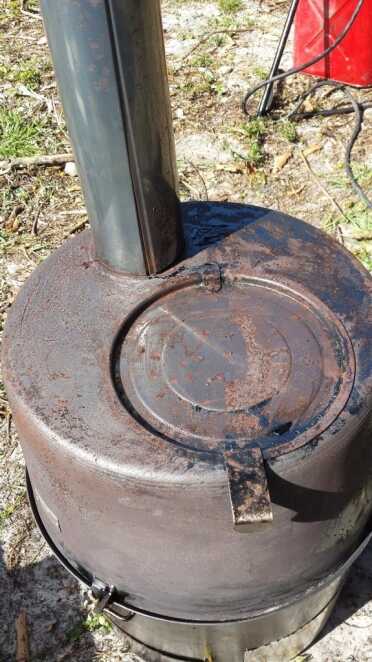
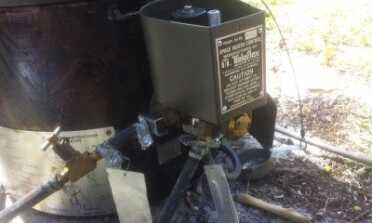
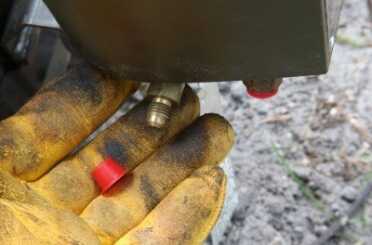

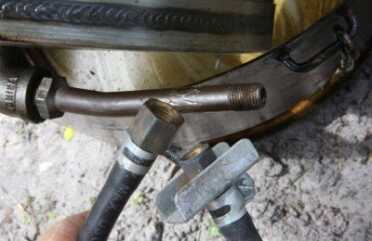

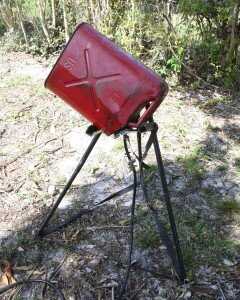
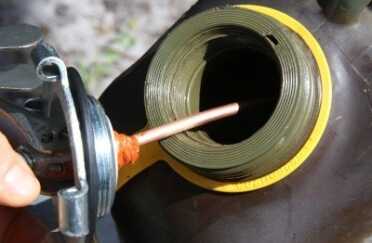

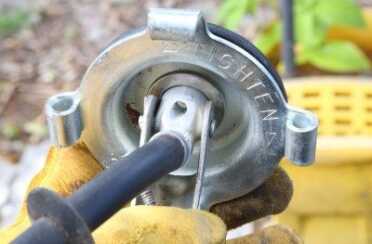
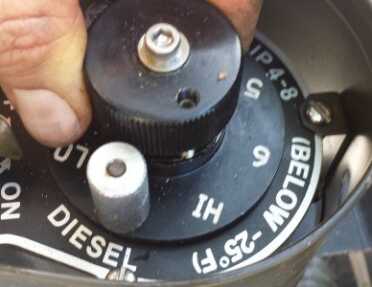
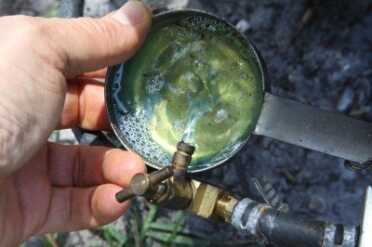
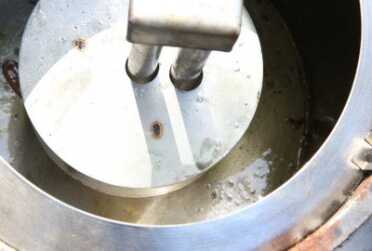
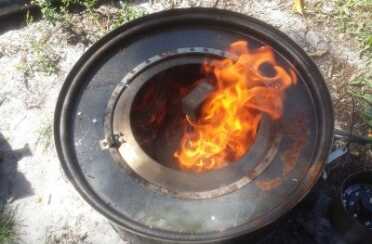
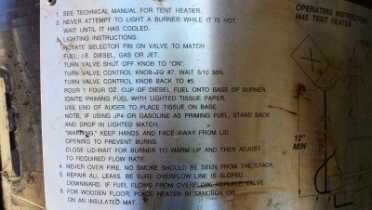


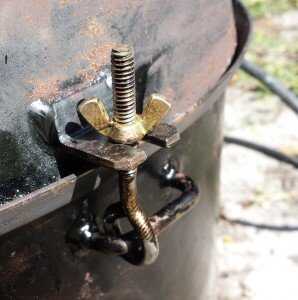
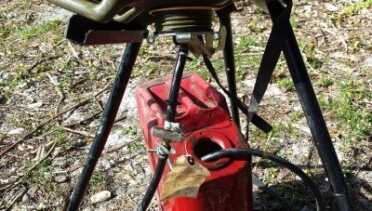

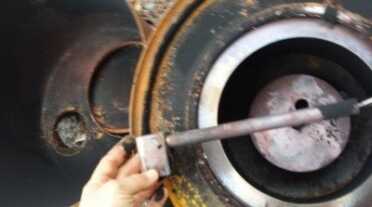
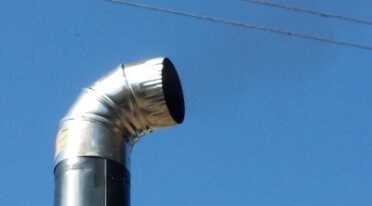
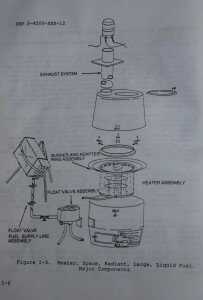
In case of emergency i had planned on using a couple elbows in this stack to vent out my basement window. Would this still cent fine with the stack not straight up? Anyone ever try that?
Hi, what is the cord / wick stuff shown in the 2nd & 4th pictures? I have searched and searched but cannot find any mention of it, but the are included with the stoves and in most pictures… also note that specs state for use up to 6k ft elevation and gasoline use for emergency only!
The guy lines are for securing the smoke stack as @ 12ft with all sections can be somewhat unstable in high winds etc. It isn’t wick or used in the stove itself at all.
does anyone have any thoughts on the possibilities of tweaking this unit a bit so as to run on one or the other or a mix of used veggie/motor oil. would like to extend growing conditions in my greenhouse for a month on either side of the regular growing season.
Has anyone a repair manual for the Teleflex fuel regulator? I have the normal manual, but that says nothing about the regulator itself.
I tested yesterday my “new” (produced in 2000, but never used) Hunter Stove Arctic with the same fuel valve as show above.
But there is no fuel coming out of the regulator. There is coming fuel out of the hose from the can, and the “switch” is set to on.
Any idea what the problem can be? And how to fix it?
Allen knows the deal so listen to him for sure..
Additionally ( Sure I missed somethings)
Great Stoves.. but they are not for use around kids or idiots or even the occasionally careless.. You can knock the whole kit and caboodle over either for a myriad of reasons.. Nothing good follows from that.
Always Always Always have a couple large Fire Extinguishers handy when your using them, Set a fire watch.. Or you can wake up dead from either carbon monoxide poisoning or as a crispy critter.
As previously mentioned parts get to glowing cherry red and will spontaneously ignite many things that touch them..
So be careful.
Painted or Oiled.(think of Moms frying pan) .. If you need them in an emergency and they are freshly painted or oiled that first has to be burned off before they can be brought into a tent or building.
If your going to leave it for a long time and not use it .. Paint or Wipe the inside down as well.
Make a lightweight plywood box to store the whole thing in and label it as such of course.
We just used rubber fuel lines in the field with these long long ago..cold enough they can get brittle… Spend the money on some Aeroquip or equivalent stainless steel coated fuel lines and get them long enough to keep the gas can well away from your tent.
Fuel flow can be an issue with the heavier oils so you need to do some winter testing..
Gee whizz … I have to test and learn and plan.. before a disaster? (Smile)
Inspect the connections carefully before each use.. If it sits long… rubber lines and gaskets will rot then leak and blah blah… poof.
Tighten stuff “enough”, German Gudentite.. but not Over tight.. Hose Clamps Brass fittings etc. Get some spares and keep them in your nice little wooden box as well as a couple screwdrivers, crescent wrench, etc. (pickup that stuff at a second hand store dont count on your “Mutitool” .. again wipe them down with some GAA (Grease) and stick them in a labeled cloth (not plastic) bag..
This is a device your crew all need to understand and drill on it’s safe employment before you put it away.. . Not something you buy and learn when you need it..
Stick to diesel and heavy oils if your environment permits.. (If you have fuel in the basement/underground you need a way to get at it.. if you must cut something thick with mo gas.. ok… but avoid straight mo gas, (what we used in the field.. with the gas can thrown up on a snow bank or the hill slightly above and aside us (so it could not leak and run into our tents (which were small arctic jobs… Dangerous is an understatement.. but on the other hand it was chilly outside..
Do I need to say the whole affair regardless of fuel is a survival tool?. and in this case dangerous as heck at best.?
Oh I have a few times.. cause it is.
Be safe..
Vic
Very Interesting! I bumped into some guys in Colorado hunting. They had one of these in a GP Medium (how big is a large?)
I had a tent that I found along the side of the road. About 9X12. I found a totally different type of stove that worked with wood. It was about a foot wide, a foot high, had legs that folded down so the stove could be on a tent floor, it was about 2 feet long. All sheet metal. The pipe broke down (disassembled) to fit inside the stove when moving it. The door had an adjustable air vent. You could stoke that baby up so that you stripped down to you long johns while it was snowing outside. Had to sell the stove, the tent and a GP Medium that I used during muzzleloading season (September–nice and warm). Anybody know the official name of my old stove or where another could be found (struggled through Obamanomics and see self sufficient light at the end of the tunnel)
look for our previous column on that stove
In the Army we called that stove a \”Yukon Stove.\” It is the much better replacement to the H-45.
Dumb-guy question. It’s not clear how to ventilate the exhaust from a tent or a building. I assume using this indoors without a way to ventilate the exhaust to the outside would be a calamity. How does one go about getting the exhaust out of the large tent or building?
You would need a stove jack. They can be bought online and sewn in.
Back in my late twenties I lived for two years in a 24 foot Nomad travel trailer and I used to supplement my propane furnace with a Kerosene space heater during those cold winter wind blown nights. As propane also ran the fridge and the stove and oven I liked to conserve it so I would only have to fill the two thirty pound tanks once a month in winter. One gallon of kerosene a night kept that old camper toasty for me and my old dog all night long. Those things work great as long as you buy a good one.
Excellent explanation and pictures. I have never used one, but would feel competent and safe now.
I have one of these, and I have used it for 2 hunting seasons now. It puts out plenty of heat on low, when it is not trying to blow up. (kidding, sort of) I originally had a plastic gas cap lid adapter only for the modern Jerry can, but it was cracked and I had
about 7 of the older metal ones anyway. I then found this metal cap and vent system separately online and bought it. That part
made a world of difference, and it generally runs much better now. It still has its moments when it starts to overheat and puff dramatically. I have had the whole top of the can and the entire stack almost see through red before I caught it one time. Do be sure to follow “all” the directions and you will have better luck in the beginning than I did. I still use it, even with the issues, because it is much better than waking up frozen to try and start a wood fired stove at 10,000 feet in September Elk Camp. Our tent is a 16′ x 20′ wall tent, and it heats it plenty fine, better than any previous heaters we have used. Good Luck. Burn it outside on your 1st run, as the cosmoline finish on the top of the can will vaporize during the 1st use.
I used one of these many times in Alaska. We would put two of these in a twelve man tent. The tents had the heavy liners in them. While these heaters do throw off some heat and worked fairly well in those drafty tents at temperatures around zero. At minus 40 and 50 below it was another story. We spent some very uncomfortable nights inside those tents. It was better than a snow shelter but still damned cold. Water would freeze in your arctic canteen while you were sleeping.
As stated these things really put out the heat. I have used them many times during my 26 years of military service. I caution users to be extremely careful when using anything but plain diesel. They will turn the entire stack cherry red if you do not watch it closely. When we used these things we had 2 in a GP Medium Tent (16′ x 32′) if memory serves me correctly. They would keep you so warm in temps down to zero and below that you didn’t hardly need your sleeping bag. If you turn them up hardly above even the lowest setting you risk setting the tent on fire. The biggest problem is most people do not use a tall enough smoke stack for them to draw properly. The stack needs to be at least 3′ taller than the tent for proper draw. They are not really meant to be used in a building as the bottom can even get hot enough to start a fire. Ever heard of the term “fire guard” I think it was invented because of these things